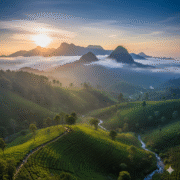
Sri Lanka – a storied island of many names, climates and wonders
- November 13, 2025
- eunoialankatours
- 6:34 pm
Set like a teardrop in the Indian Ocean, Sri Lanka is a land of layered names, shifting climates and astonishing natural richness. The world knows it today as Sri Lanka – “resplendent island” – but this luminous title is only the latest chapter in a long history of names.
- Classical Sanskrit poetry called it Lanka, “island.”
- Sinhala legends recall how Prince Vijaya, landing in the sixth century BCE, christened it Thambapanni or “Copper-palmed” island.
- Greek merchants heard this and called the island Taprobane.
- Arab sailors, dazzled by its gem fields, softened the Sanskrit Ratnadwipa (“island of gems”) into Serendib, giving the English language the word “serendipity.”
- European traders later coined Ceylon, which held until independence; in 1972 the nation reclaimed its luminous self-image by adopting the name Sri Lanka.
A Tiny Kingdom Off the Indian Coast
From the air, Sri Lanka is a pear-shaped emerald hanging off the southern tip of India. Separated from the subcontinent by the shallow Palk Strait, the island lies roughly 60 km from the Indian mainland. It stretches about 435 km from north to south and about 225 km across at its widest point.
These modest dimensions hide an extraordinary diversity:
- The island contains over 103 river basins, sixteen of which are longer than 100 km.
- Its coastline snakes 1,340 km and forms 82 lagoons.
- Though small, Sri Lanka is administratively complex: nine provinces fan out from the central highlands, subdivided into 25 districts. You can drive from one province into another in an afternoon, crossing landscapes that feel like different countries.
Landscapes Sculpted by Monsoon and Mountain
Sri Lanka sits between 5.5° and 9.5° N latitude and straddles the north-east monsoon (December to March) and south-west monsoon (May to October).
- Lowlands are tropical, with average daytime temperatures between 26 °C and 29 °C.
- The central highlands, however, are refreshingly cool: towns like Nuwara Eliya can dip below 16 °C.
Rainfall patterns divide the island into four climatic zones:
- The wet zone (south-west and mountains) receives over 2,500 mm of rain a year.
- The dry zone (north and east) averages around 1,750 mm.
- An intermediate zone bridges the two.
- Small pockets on the north-west and south-east coasts form an arid zone receiving less than 900 mm.
Underlying these climates are three peneplains that give Sri Lanka its distinctive topography, soaring to 2,770 m around Pidurutalagala. Rivers radiate from these highlands like spokes; the Mahaweli Ganga, at 335 km, is the longest. The high relief also nurtures 382 recorded waterfalls – one of the highest waterfall densities in the world.
Islands of Biodiversity
Sri Lanka’s varied elevations and climates create an astonishing ecological mosaic. Tropical lowland rainforests, montane cloud forests, and dry-zone evergreen forests blanket the landscape.
- The island counts 26 national parks covering over 5,700 km², including two marine parks.
- Yala National Park is famous for having one of the highest leopard densities on Earth (about 25 Sri Lankan leopards roam its Block I).
- Sri Lanka also hosts the highest density of elephants in Asia, with a resident herd in Yala numbering 300–350 individuals.
UNESCO Natural World Heritage Sites:
- Sinharaja Forest Reserve: The last sizeable remnant of primary tropical rainforest in the country; more than 60% of its tree species and about half of Sri Lanka’s endemic animals live within its shade.
- The Central Highlands of Sri Lanka: Comprising the Peak Wilderness, Horton Plains and Knuckles Conservation Forest. These highland refuges are part of the greater Western Ghats–Sri Lanka biodiversity hotspot, harbouring 141 endemic vertebrates, including a unique sub-species of leopard and the purple-faced langur.
A Cornucopia of Crops and Minerals
The abundance of water and sunshine underpins a flourishing agricultural tradition.
Agriculture:
- Paddy remains the staple, grown in nearly every district, dictated by the Maha (Nov–Feb) and Yala (May–Aug) monsoon seasons.
- Tea, introduced by the British in the 19th century, is the island’s signature export, flourishing on the manicured slopes around Nuwara Eliya and Kandy.
- Coconut palms fringe the coasts, and rubber trees thrive in the wet zone, forming the triad of plantation crops alongside tea.
- Spices like cinnamon, clove, nutmeg, and pepper continue a trade that once drew Arab and European merchants to its shores.
Below Ground Treasures:
- Sri Lanka is rich in industrial minerals like heavy mineral sands (ilmenite, rutile, zircon) from the north-east beaches, and graphite from the central hills.
- Gemstones are the island’s most romantic export. For over two millennia, Sri Lanka has produced sapphires, rubies, spinels, and cat’s-eyes, with more than 130 varieties recorded. Sapphires alone account for about 85% of gem export value, and Sri Lanka has supplied some of the world’s most famous stones, including the 563-carat Star of India.
The Gift of Identity
Understanding Sri Lanka’s geography and resources reveals why the island has been coveted, colonised, and celebrated for millennia. Its many names tell stories of natural riches—shining waters, copper shores, precious stones—while its landscapes range from coastal lagoons and dry scrub to misty tea estates and cloud-draped peaks.
From the last remaining tropical rainforests and leopard-rich savannahs to gem-strewn riverbeds and fragrant spice gardens, Sri Lanka deserves its title as the Resplendent Island – a place whose beauty and abundance continue to inspire wonder and, perhaps, a serendipitous sense of discovery.


